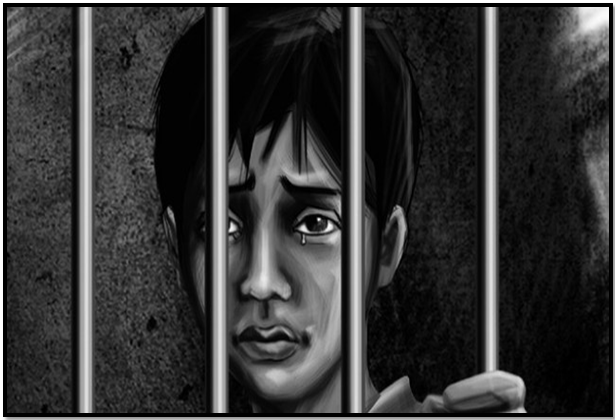TRYING JUVENILES AS ADULTS IS NOT THE ANSWER
Source: indiatomorrow.net
Relevance:
- GS 2 – Mechanisms, Laws, Institutions, and Bodies Constituted for the Protection and Betterment of Vulnerable Sections, Welfare Schemes for Vulnerable Sections of the Population by the Centre and States.
Why in the News?
In May, a speeding car allegedly driven by a teenager resulted in the tragic deaths of two young techies in Pune. Under the Juvenile
Justice (Care and Protection of Children) Act, 2015, the adolescent initially faced the Juvenile Justice Board (JJB), which granted bail under perceived lenient conditions. This decision, compounded by the incident’s outcome and accusations of privilege influencing the investigation, sparked public outcry.
Focus:
Background of Juvenile Justice in India
- The Juvenile Justice (Care and Protection of Children) Act, 2015 (JJ Act), aims to provide care, protection, development, treatment, and social reintegration of children in difficult circumstances through a child-friendly approach.
- The Act allows for trying adolescents above 16 years as adults in cases involving “heinous” offences.
Recent Developments
- Pune Case: Following public backlash, the JJB revised its order, directing the adolescent’s detention in an Observation Home. This decision was contested in the Bombay High Court, which ordered his release, citing compliance with due process.
- Legal and Social Responses: The High Court affirmed that the JJ Act is not just beneficial but remedial. The debate over prosecuting juveniles as adults raises broader questions about the efficacy of juvenile justice in addressing severe offences like drunken driving and demands for accountability in cases involving young offenders.
Legal Framework and Key Judgments
Resolving juvenile justice cases involves navigating a complex legal framework and significant judicial interventions. Critical legal aspects and rulings include:
- Juvenile Justice (Care and Protection of Children) Act, 2015: Addresses the adjudication and rehabilitation of juveniles in conflict with the law, prioritizing rehabilitation over punishment.
- Provisions for Heinous Offences: Permits trying adolescents above 16 years as adults for offences with a minimum seven-year sentence.
- Supreme Court Guidance: Emphasizes rehabilitation rather than retribution in handling juvenile cases through various rulings.
Constitutional Provisions relevant to juvenile justice in India
Application in Juvenile Justice
|
Arguments Against Trying Juveniles as Adults
- Developmental Psychology: Adolescence, marked by immature judgment and underdeveloped impulse control, is a temporary stage. The UN Committee on the Rights of the Child stresses rehabilitation and social reintegration over punishment, noting adolescents’ higher neuroplasticity enhances receptivity to change.
- Impact on Rehabilitation: Shifting juveniles to adult courts can impede their rehabilitation. The juvenile justice system prioritizes avenues for positive transformation often unattainable within the punitive adult justice system’s rigid confines.
- International Practices: Research from Indonesia and the U.S. reveals that treating juveniles as adults fails to reduce recidivism effectively. Practices like requiring convicted drunk drivers to face victims or their families can yield more profound impacts.
Seeking Accountability
- The juvenile justice system centers on holding offenders accountable while ensuring rehabilitation.
- When juveniles commit crimes, the JJ Act empowers the JJB to craft responses tailored to each case.
- This approach can promote accountability and healing, offering justice opportunities typically unavailable within adult systems.
Rehabilitation and Reintegration Strategies
- Individualized Care Plans: Tailored rehabilitation plans consider each juvenile offender’s socio-economic background, offense nature, and psychological state. These may encompass therapy, education, vocational training, and community service.
- Family and Community Involvement: Engaging families and communities supports a nurturing environment for juveniles. This holistic approach addresses underlying causes of delinquency, aiding reintegration.
- Educational and Vocational Training: Access to education and vocational skills equips juveniles for post-rehabilitation life, reducing reoffending risks by providing legitimate livelihood avenues.
- Psychological Support and Counseling: Addressing mental health through counseling is vital, as many juveniles in conflict suffer from untreated psychological issues.
- Community-Based Programs: Involvement in community service fosters responsibility and belonging. It also serves restorative justice by allowing juveniles to make amends.
Legal and Policy Recommendations
- Strengthening the JJ Act: Enhancing implementation involves better training for JJB members, improving observation home infrastructure, and evaluating rehabilitation programs.
- Alternative Dispute Resolution: Introducing mediation and restorative justice mechanisms promotes constructive resolution of juvenile cases.
- Public Awareness Campaigns: Educating the public on juvenile justice principles emphasizes rehabilitation’s superiority to punishment, garnering support for humane approaches.
- International Cooperation: Learning from successful systems abroad can enhance India’s juvenile justice policies, adapting best practices to local contexts.
Dimensions relevant for exam:
|
Conclusion:
The issue isn’t the perceived leniency or “misuse” of the juvenile justice system but the failure to fully implement its foundational principles. Trying adolescents as adults avoids addressing weak juvenile justice system implementation and fails to meet adolescents’ developmental and rehabilitative needs. A balanced approach that emphasizes rehabilitation, accountability, and social reintegration is crucial for effectively addressing juvenile crimes.
Mains Question:
Discuss the key challenges in the juvenile justice system in India. Suggest pragmatic solutions to ensure accountability and rehabilitation of juveniles in conflict with the law. (250 words)
Source: The Hindu
Associated Article:




